Mushroom foraging can be a thrilling adventure that lets you delve into the wonders of nature — all while finding delicious, healthy food. But watch out! Some types of mushrooms are poisonous and could harm you if ingested. In this beginner’s guide, we’ll show you the essentials of how to start your mushroom foraging journey safely and confidently, so you can relish this enjoyable activity.
Basic Rules for Beginner Mushroom Foragers
Familiarize Yourself With Mushroom Gathering Laws
Before you go mushroom picking, ensure you know the rules. To avoid legal problems, review these tips beforehand.
Permits for Mushroom Picking
You can pick mushrooms for personal use on National Forest land without a permit. But, if you want to pick them for sale, you’ll need a permit from Forest Service field offices. Furthermore, you must apply for a separate permit to gather mushrooms for educational or research reasons.
Limits on the Amount and Types of Mushrooms You Can Collect
Rules can vary place to place and always check with local ordinances, but you need to ensure you only pick a certain amount of mushrooms and species of mushrooms. For example, if you’re picking one type, you can only collect one gallon per day. When picking more than one type, only collect three types daily, but each species can have one gallon.
National Park Rules for Mushroom Gathering
Many national parks don’t allow people to pick mushrooms. Yet, in a few parks, you can gather a small number of mushrooms that are safe to eat. However, there is a daily possession limit for wild mushrooms per person. So, before going, ensure to review the park’s rules. You can find this information online.
Tools Allowed for Cutting Mushrooms
Depending on where you are, only small tools like scissors and knives may be allowed to cut mushrooms. Using other tools may against the rules. Also using things like rakes and shovels can damage the mushroom’s habitat.
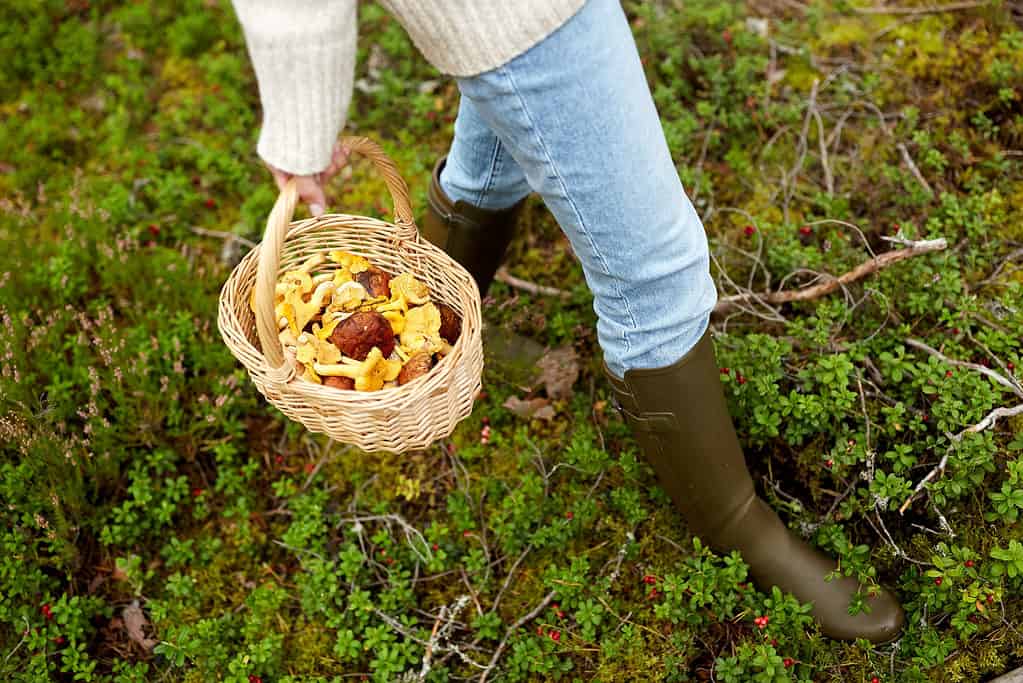
Before you go mushroom picking, make sure you know the rules of where you are picking from.
©iStock.com/dolgachov
Wear Appropriate Clothing and Footwear
Before you set out on your mushroom foraging adventure, it’s crucial to dress appropriately for the occasion. Wear reliable shoes or boots that can endure damp and unsteady surfaces. Similarly, consider wearing pants that cover your legs and a long-sleeved shirt to protect your skin from scratches and insect bites.
Gather the Right Species
As a novice mushroom hunter, your primary worry should be consuming the wrong species, possibly leading to poisoning. Unfortunately, distinguishing between toxic and nontoxic species in the wild can present a formidable challenge. Folk beliefs are an unreliable guide, and the toxicity levels of a given species can fluctuate depending on the location and timing of its harvest.
Thankfully, less than ten people die from mushroom poisoning yearly in the United States. Typically, people experience mild symptoms such as:
- Nausea
- Stomach cramps
- Dizziness
- Diarrhea
Tips to Avoid Poisonous Varieties
To avoid mushroom poisoning, get to know the mushrooms you plan to gather and educate yourself on any poisonous look-alikes. Although not guaranteed, following these guidelines can help eliminate some more hazardous species.
Avoid Mushrooms that are Mostly White, off White or Small and Brown.
Most mushroom deaths are attributed to consumption of deadly Amanita. Many of these mushrooms are all white, but one, the “death cap” has a cap that can be off white to yellow’ish to green. Some other deadly mushrooms are small and brown like the “deadly Galerina“
Beware of White Gills and Skirts
Don’t take chances with mushrooms with white gills, a skirt or ring around the stem, or a bulging base known as a volva. These may seem tempting, but they belong to the genus Amanita which contains some very toxic species.
Cook Mushrooms Thoroughly
Avoid eating raw mushrooms at all costs, even the ones deemed safe. It’s best to cook them thoroughly to eliminate any potential toxins that could harm your health.
Always Be Certain About the Mushrooms You Consume
Finally, be certain about the mushrooms you consume.
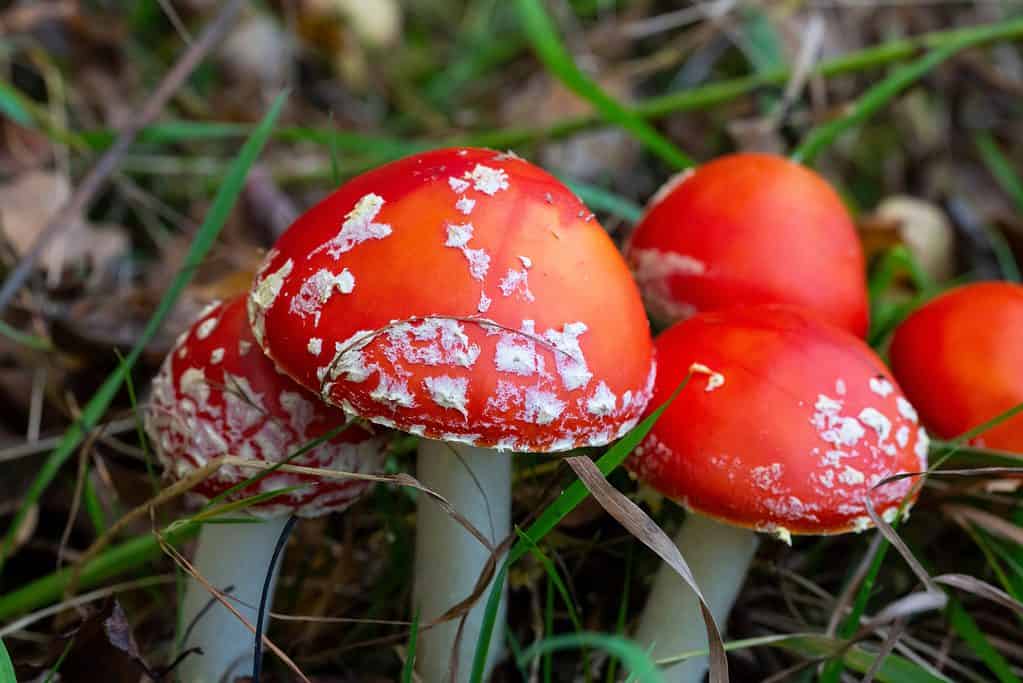
Fly agaric, or
Amanita muscaria, is not edible.
©FotoLot/Shutterstock.com
Be Responsible
To ensure the sustainability of mushroom species and the wildlife that relies on them, you must become a responsible mushroom collector. Some wild animals rely on mushrooms for food. Here are four recommendations for responsible mushroom hunting or foraging.
Collect Responsibly
You should avoid picking too many mushrooms to be considerate towards other gatherers and avoid having an excess that may spoil before use. Leaving some will preserve the animals’ food source.
Pay Attention to Spores
When gathering mushrooms, please pay attention to spores because mushrooms replicate through them. Select mature mushrooms that have already released their spores, and use baskets or mesh bags to gather them. This allows for the release of spores and prevents the use of plastic bags (plastic bags also make the mushrooms spoil faster).
Leave Undesirable Mushrooms
It’s recommended to leave behind undesirable mushrooms, such as those that are buggy, dirty, or old, and let them complete their life cycle. Recognizing mushrooms as such will help you avoid collecting them, and leaving them behind will help preserve the mushroom population.
Use Proper Harvesting Techniques to Minimize Disturbance
It’s essential to learn proper harvesting techniques. Never rake up small buttons of mushrooms like the rare matsutake. Also, don’t use shovels as you can disturb the local habitat.
12 Common Mushroom Species
North America is home to numerous types of fungi. This compilation of the top 12 edible mushroom species to gather consists of the continent’s most available and delicious varieties. Many of these species can be identified with some research and outdoor exploration.
If you’re interested in gathering mushrooms for cooking and not the mind-altering kind, this list is a great place to begin. However, it’s worth noting that not every species on this list is found everywhere in North America. So before heading out, try and figure out which ones grow in your region to avoid disappointment.
1. Chicken of the Woods
Chicken mushroom of the Woods is a favorite among beginners because of its vibrant orange color and unique shelf-like shape. There are not many other mushrooms that look like this.
This mushroom has a dense, meaty texture that’s so satisfying. You can eat it for days! It has a unique lemony taste that some people think tastes like chicken. It is very important that this mushroom is cooked thoroughly before consuming though, as it can give some people severe GI distress if not.

or chicken of the woods mushroom growing on the side of a tree.
©Marc Venema/Shutterstock.com
2. Morels
Morel mushrooms have a nutty and earthy taste with a meaty texture. People who love mushrooms, including chefs, highly desire them because they only grow in the wild, unlike the mushrooms you find in grocery stores. Morels come in different sizes and colors, from oblong to bulbous and blonde to gray.
You can easily spot them by their honeycomb-like exterior and white, hollow inside. Although people have tried to farm them, it’s tough, so they must be gathered from where they naturally grow. You’ll find them mainly in forests across North America and Europe, where it’s humid and cozy.

Morels are highly prized for their flavor and come in different sizes and colors.
©Mircea Costina/Shutterstock.com
3. Dryad’s Saddle
When a morel hunter comes up empty-handed, they can usually find Dryad’s saddle, a common edible fungus in the spring. However, they can become leathery as they age, making them not worth bringing to the dinner table. Unlike morels, Dryad’s saddles are easy to spot because they grow on dead tree trunks as shelves. This mushroom species was first described in 1778 by botanist William Hudson, who called it Boletus squamosus. Later, mycologist Elias Magnus Fries renamed it Polyporus squamosus in 1821.
The caps of Dryad’s saddle mushrooms can grow 15 to 30 cm across and up to 5 cm thick. They usually grow in layers attached to the tree with a short, darkening stem. The caps have different shapes but are primarily semi-circular, fan-shaped, or kidney-shaped. They start out round and bulging but eventually flatten out and may have a slight or deep depression. Dryad’s saddle mushrooms are usually pale tan with big, flat scales that are brown or almost black. Some people liken their flavor and texture to that of watermelon rind.
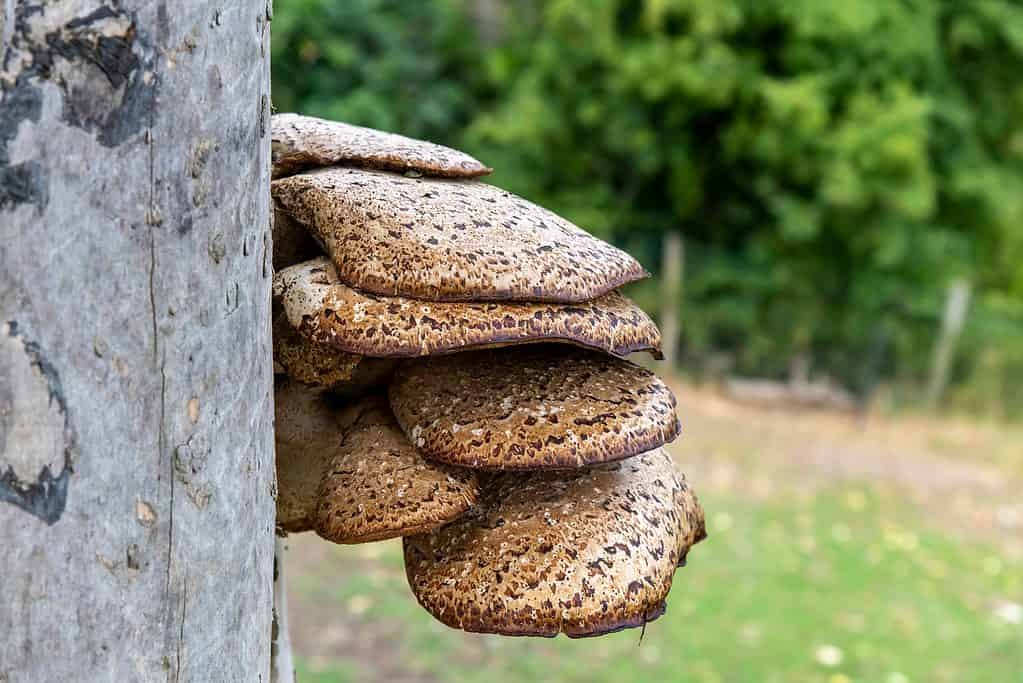
Close-up view of layers of Dryad’s Saddle mushrooms (
Polyporus squamosus) on the side of a wooden pole.
©365 Focus Photography/Shutterstock.com
4. Oyster
People worldwide love oyster mushrooms because they have a soft texture and a mild, yummy taste. They usually look like a fan or an oyster in white, gray, or tan. You will normally find them in large groups or clusters. Oyster mushrooms don’t need much preparation since you can use them whole or chopped. They cost more than white button mushrooms but are still cheaper than rare mushrooms like morels. Plus, mushrooms can even be used to make leather and furniture.
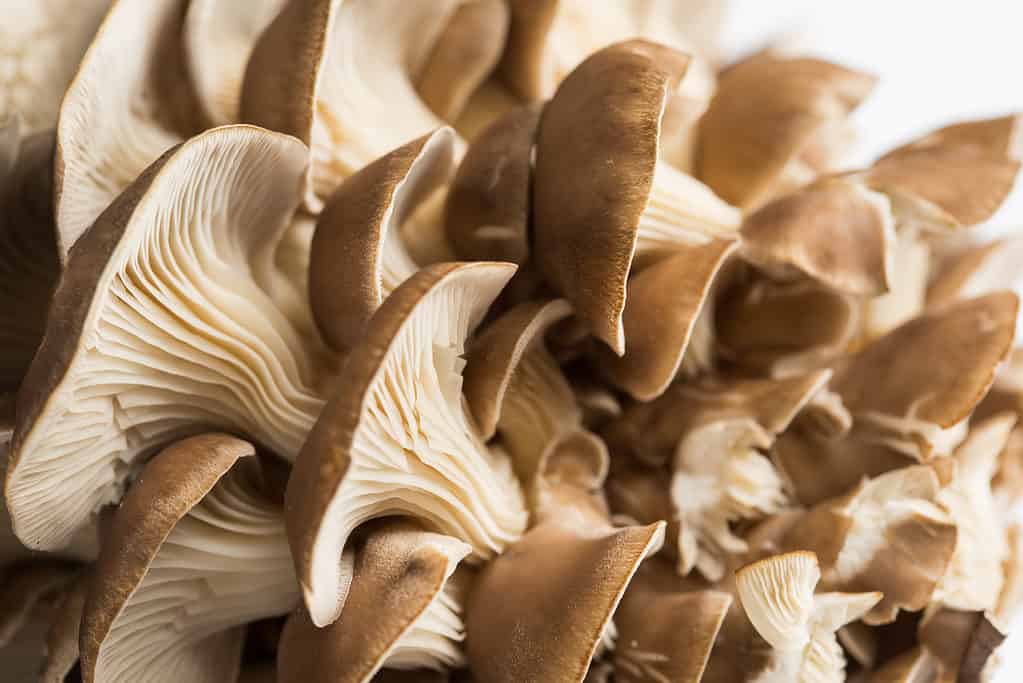
Oyster mushrooms growing in a cluster.
©Tiplyashina Evgeniya/Shutterstock.com
5. Chanterelles
Chanterelles mushrooms are another common type of wild mushroom. They are easy to spot in the forest during the summer because of their yellow or orange color.
These mushrooms can have caps that range from 2 to 5 inches, but they’re typically around 2 inches. Like some other mushrooms, their caps aren’t round and symmetrical. Instead, they usually have a wavy, funnel-like shape.
Chanterelles stand out from other mushrooms because of their false gills. You can tell that these gills aren’t like those on other mushrooms because they’re thicker, blunter, and look forked.

Other non-edible mushroom species mimic the golden color of chanterelles.
©Paula Savelius/Shutterstock.com
6. Hen-of-the-Woods
The Hen-of-the-woods mushrooms, sometimes called maitake mushrooms, tend to grow together in bunches at the bottom of trees. They’re light brown and feathery and are named after their hen-like appearance. These mushrooms taste solid and savory, with an earthy flavor and a “spicy ending.”
They grow on or around the base of oak trees or stumps. You can often find them in hardwood forests with old and mature trees, especially in damp woodlands and close to rivers. The Hen-of-the-Woods mushrooms usually grow in the same spot yearly in late summer or early autumn.
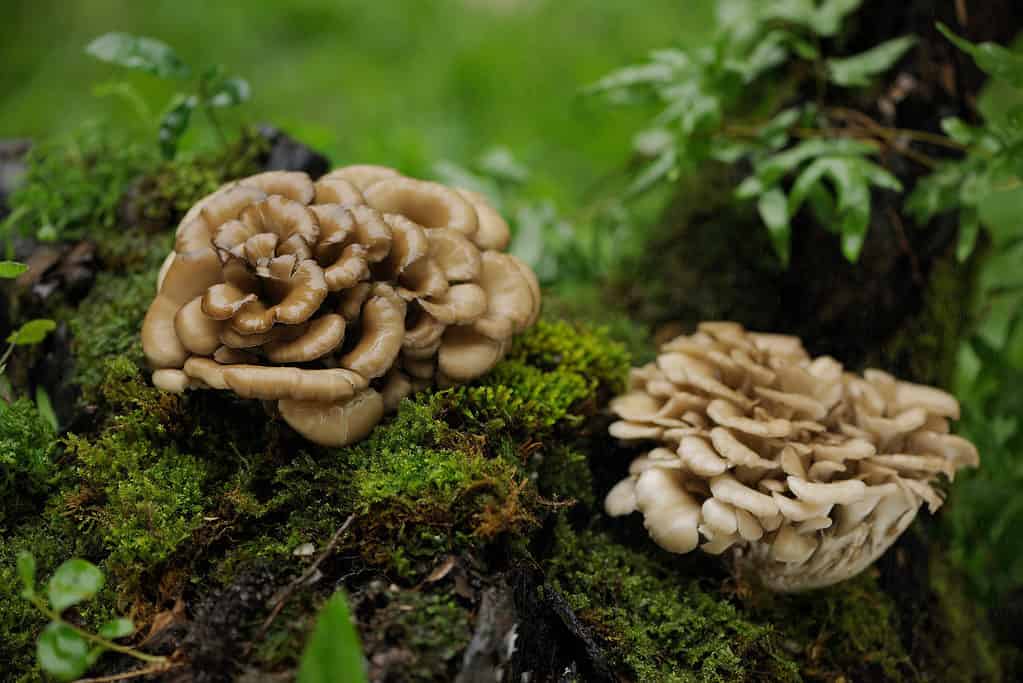
Two maitake mushrooms on tree logs.
©iStock.com/ueapun
7. The Black Trumpet
The black trumpet is a mushroom that grows in the wild and can be eaten. Many field guides will tell you that the scientific is Craterellus cornucopioides and that is the species most commonly found in Europe. In the U.S. however you will find Craterellus calicornucopioides, Craterellus fallax and some others.
It has other names, too, like the “horn of plenty” mushroom, which comes from a story in Greek mythology about a magical horn that fills itself with food and drink.
In many cultures, the black trumpet mushroom is called the “trumpet of the dead.” However, this name doesn’t mean the mushroom is poisonous. Instead, people used to imagine that the mushrooms were trumpets played by ghosts underground.
A black mushroom grows in forests with hardwood trees and likes to grow at the bottom of broad-leaved trees like oak or beech. Many people seem to like these mushrooms incorporated into cream sauces.

Black trumpet mushrooms growing in the wild.
©SariMe/Shutterstock.com
8. Hedgehog
These mushrooms come in different sizes, from small to large, and have irregular shapes. They have a flat cap and a thin stem not in the center.
Hedgehog mushrooms look like regular mushrooms with a stem and a cap. However, their name comes from their unique way of making spores. Instead of gills or pores on the bottom of their caps, they have short spines or teeth hanging vertically.
These mushrooms have thick caps that can be buff, yellow, or orange. As they mature, their edges become delightfully wavy and may exhibit cracks. Their stems are similarly colored in orange, buff, or white and can be hollow in the center. Hedgehog mushrooms have a chewy texture and offer a delightful fruity aroma. They have a lovely combination of earthy, nutty, peppery, and smoky flavors that are simply delicious.
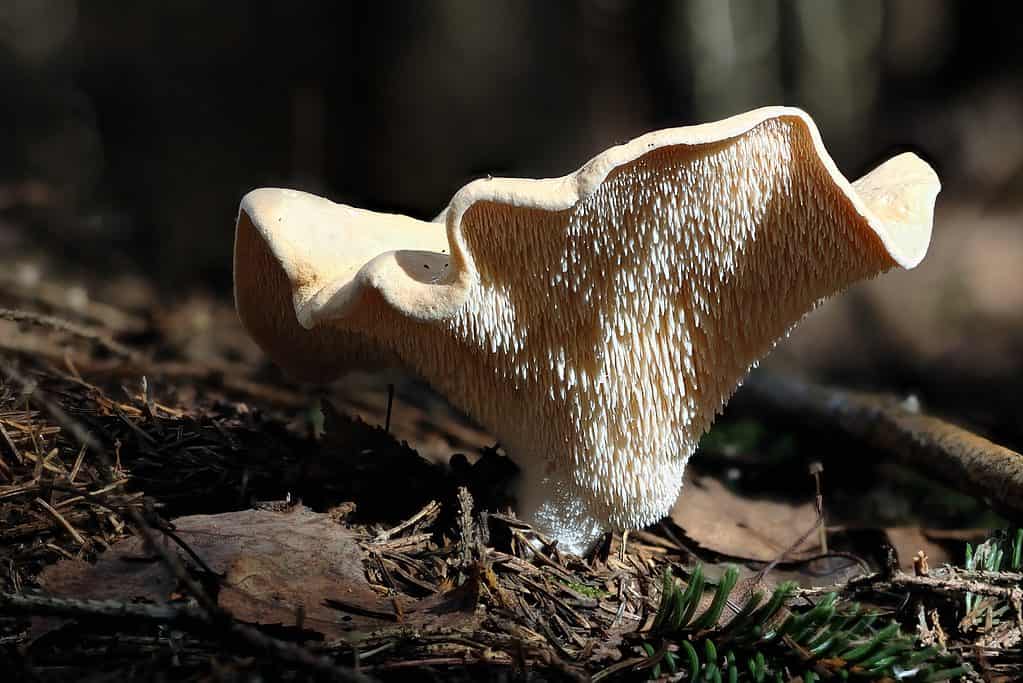
Yellow hedgehog mushroom (
Hydnum repandum).
©JO2/Shutterstock.com
9. Porcini
“Porcini mushrooms” are part of a group of mushroom called the boletes. These boletes include many safe-to-eat mushrooms. Not all boletes are good to eat, but very few are deadly.
Unlike some mushrooms, boletes don’t have gills. Instead, they have pores underneath their caps where spores are released. This makes them look different from other mushrooms. In addition, most boletes only grow near the roots of certain trees, such as oaks. They work together with these trees to develop.
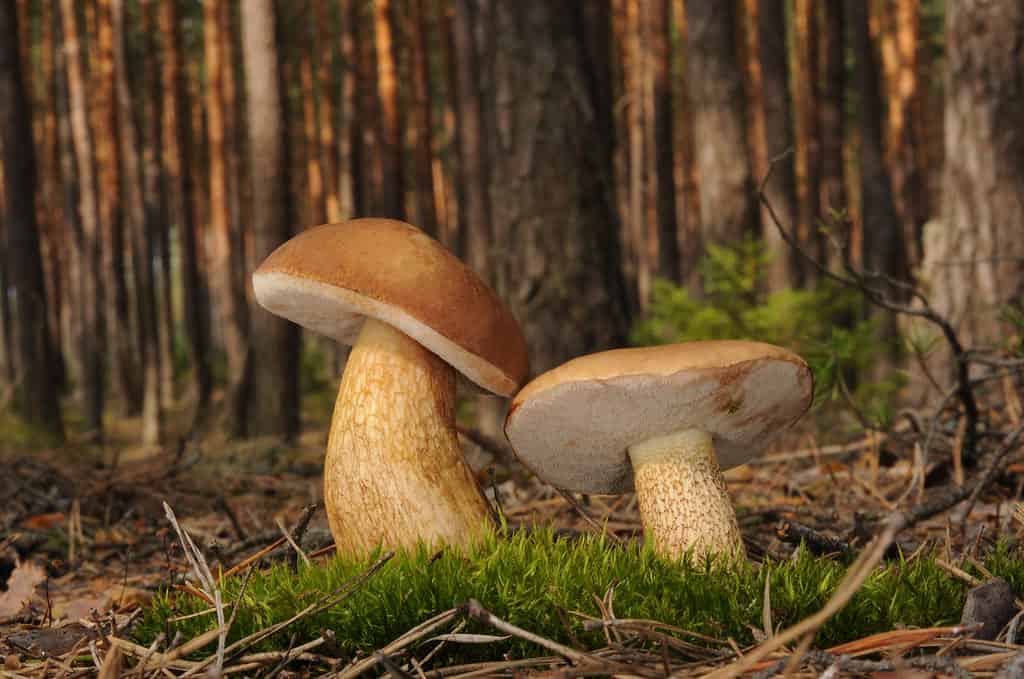
The stipes of all boletes are centrally located under their caps.
©Tomasz Czadowski/Shutterstock.com
10. The Saffron Milky Cap
Have you ever seen mushrooms that ooze a white, milk-like substance when sliced? These are called Milky Caps, and their distinguishing feature makes them easy to recognize. However, not all Milky Caps are safe to eat, but the edible ones are delightful. Among the Milky Caps species, the Saffron Milky Caps, also known as Lactarius deliciosus, are the top choice for foodies. Their scientific name even includes the word “delicious” for a reason.
Many people are familiar with these Lactarius/Lactifluus mushrooms because they are popular, and there are over 500 species of them. However, there are probably even more types that we don’t know about yet. There are at least 100 species in North America.
Even though many milky cap mushrooms look similar to the Saffron milky cap mushroom, it and it’s close relatives are easy to spot in the forest because of its bright orange color and green staining gills. It tastes mild and has a dense texture, making it a delicious mushroom.
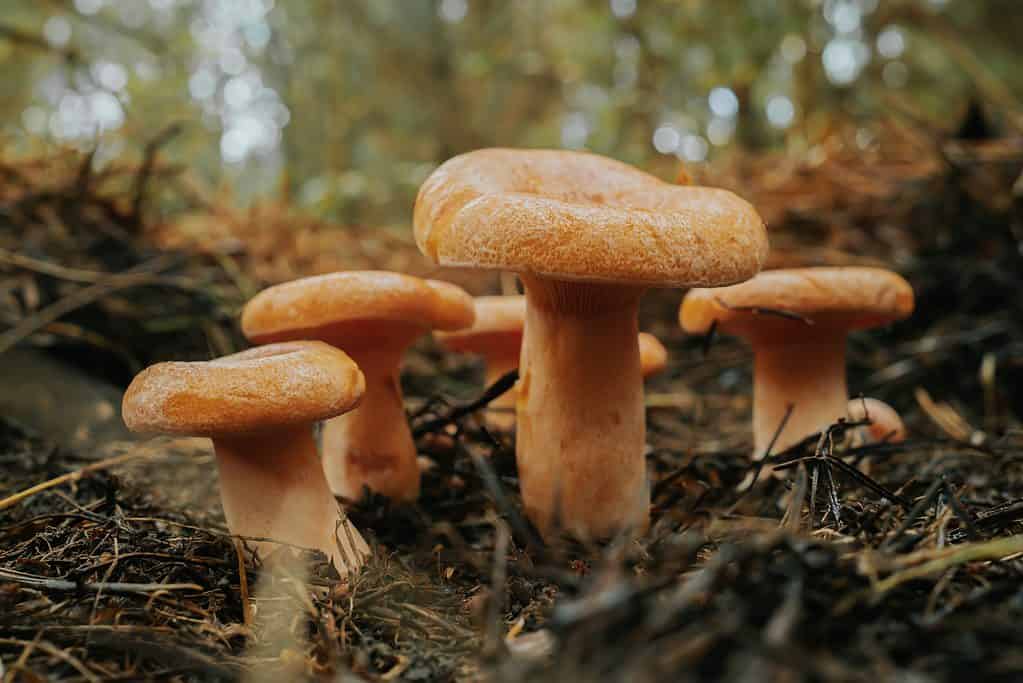
Saffron Milky Caps (
Lactarius deliciosus var.).
©Stock Holm/Shutterstock.com
11. Shaggy Mane
Shaggy manes are a delicious type of mushroom that many people love to eat. But here’s the catch: they don’t last long. Shaggy manes typically only stick around for 24 hours before they start to turn into mush. Interestingly, these mushrooms don’t release their spores easily.
DNA studies have shown that shaggy manes are closely related to some species of Agaricus and Lepiota, but not too many other mushrooms whose gills turn black. It’s worth noting that shaggy manes look a bit like another edible mushroom called Tippler’s Bane (Coprinopsis atramentarius), but you need to be careful with those. If you eat them within 48 hours of drinking alcohol, it can cause some severe health issues.
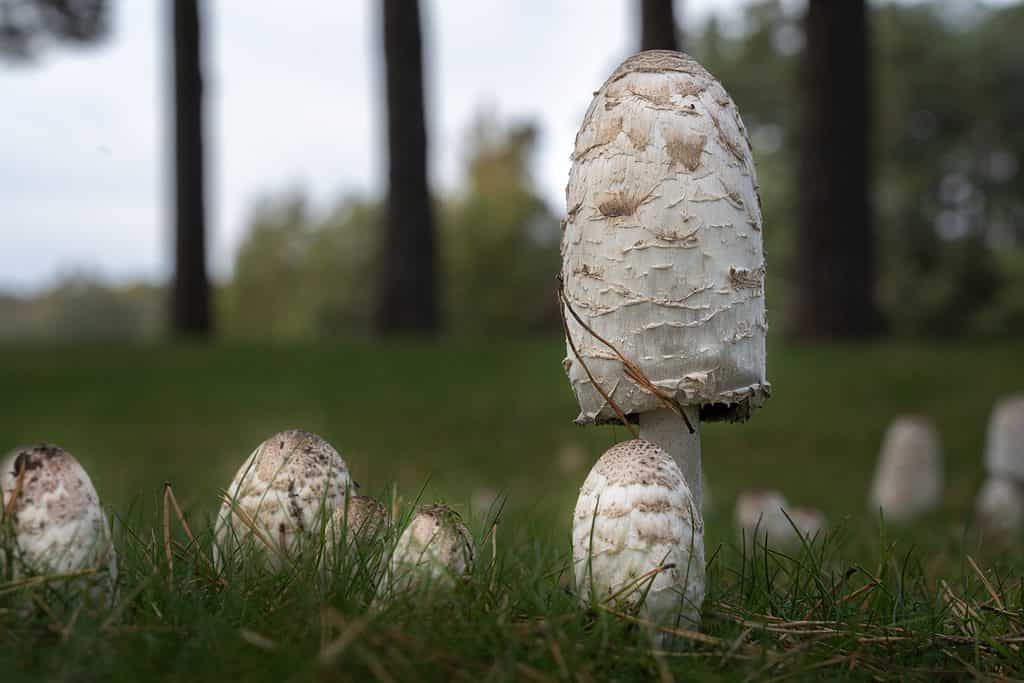
Shaggy Mane Mushrooms (
Coprinus comatus).
©UKSTUDIO/Shutterstock.com
12. Indigo Milk Cap
The Indigo Milk Cap is another milky mushroom belonging to the Russulaceae family. It’s also called the “blue milk mushroom”. You can easily recognize it because of its distinctive blue color. And if you cut it, it oozes dark blue milk.
While similar-looking mushrooms exist, like the Lactarius chelidonium and Lactarius paradoxus, they only resemble the indigo milk cap when they’re young and haven’t developed their yellow and brown hues (plus, they have different-colored milk).
This mushroom grows prevalently over the east coast of the U.S. and is not hard to spot. The indigo milk cap also habitually reappears in the same spot year after year.
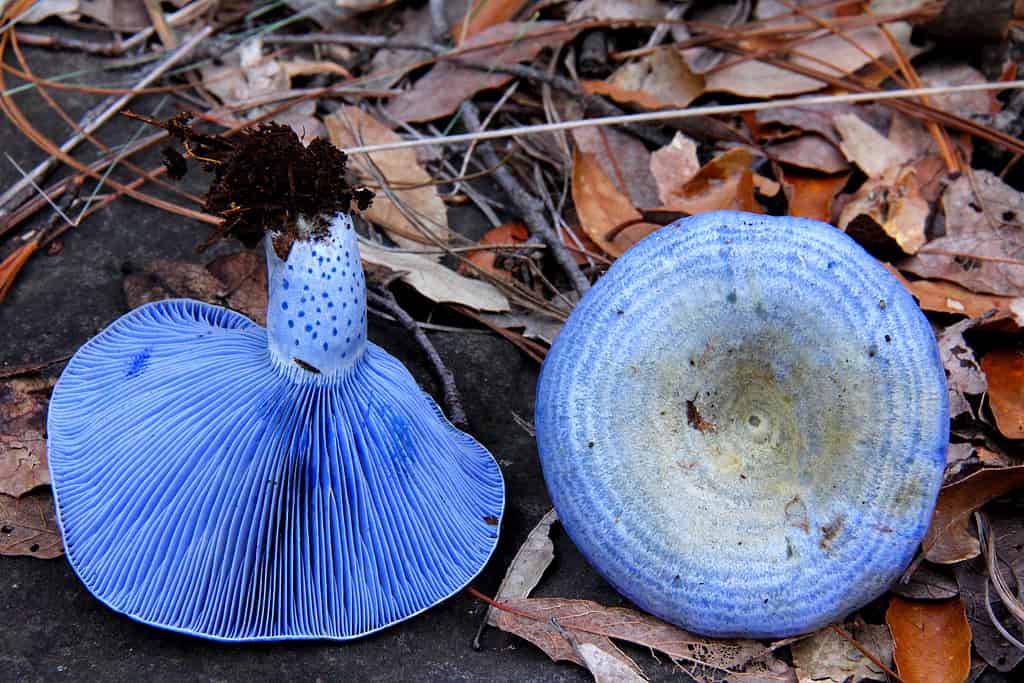
Indigo Milk Cap (
Blue lactarius).
©Gajda/Shutterstock.com
Start Your Mushroom Foraging Journey with Confidence
Mushroom foraging is a fun and rewarding hobby that can enrich your life and diet. However, it also requires knowledge and preparation to avoid potential dangers and legal issues. By following the basic rules outlined in this guide, you can confidently start your mushroom foraging journey and enjoy the fruits of your labor. Remember always to respect nature and only pick what you need.
The photo featured at the top of this post is © iStock.com/PIKSEL
The information presented on or through the Website is made available solely for general informational purposes. We do not warrant the accuracy, completeness, or usefulness of this information. Any reliance you place on such information is strictly at your own risk. We disclaim all liability and responsibility arising from any reliance placed on such materials by you or any other visitor to the Website, or by anyone who may be informed of any of its contents. None of the statements or claims on the Website should be taken as medical advice, health advice, or as confirmation that a plant, fungus, or other item is safe for consumption or will provide any health benefits. Anyone considering the health benefits of particular plant, fungus, or other item should first consult with a doctor or other medical professional. The statements made within this Website have not been evaluated by the Food and Drug Administration. These statements are not intended to diagnose, treat, cure or prevent any disease.
Thank you for reading! Have some feedback for us? Contact the AZ Animals editorial team.







